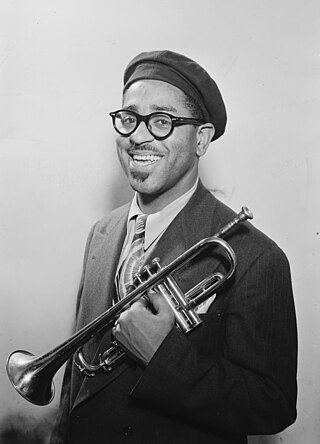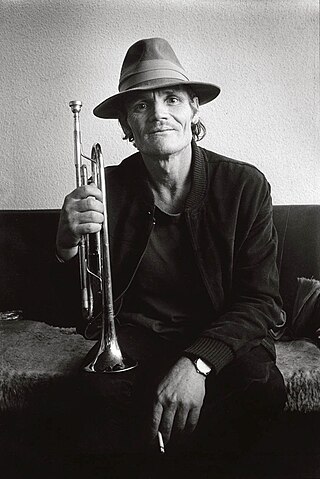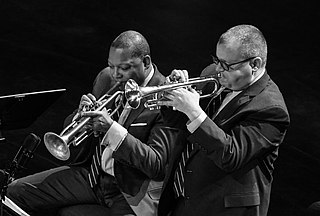Related Research Articles

Bebop or bop is a style of jazz developed in the early-to-mid-1940s in the United States. The style features compositions characterized by a fast tempo, complex chord progressions with rapid chord changes and numerous changes of key, instrumental virtuosity, and improvisation based on a combination of harmonic structure, the use of scales and occasional references to the melody.

John Birks "Dizzy" Gillespie was an American jazz trumpeter, bandleader, composer, educator and singer. He was a trumpet virtuoso and improviser, building on the virtuosic style of Roy Eldridge but adding layers of harmonic and rhythmic complexity previously unheard in jazz. His combination of musicianship, showmanship, and wit made him a leading popularizer of the new music called bebop. His beret and horn-rimmed spectacles, scat singing, bent horn, pouched cheeks, and light-hearted personality have made him an enduring icon.

Maxwell Lemuel Roach was an American jazz drummer and composer. A pioneer of bebop, he worked in many other styles of music, and is generally considered one of the most important drummers in history. He worked with many famous jazz musicians, including Clifford Brown, Coleman Hawkins, Dizzy Gillespie, Charlie Parker, Miles Davis, Duke Ellington, Thelonious Monk, Abbey Lincoln, Dinah Washington, Charles Mingus, Billy Eckstine, Stan Getz, Sonny Rollins, Eric Dolphy, and Booker Little. He also played with his daughter Maxine Roach, Grammy nominated Violist. He was inducted into the DownBeat Hall of Fame in 1980 and the Modern Drummer Hall of Fame in 1992.

Earl Rudolph "Bud" Powell was an American jazz pianist and composer. A pioneer in the development of bebop, jazz critics have commented that his compositions and playing style "greatly extended the range of jazz harmony," and his application of complex bebop phrasing to the piano influenced both his contemporaries and later pianists including Walter Davis, Jr., Toshiko Akiyoshi, and Barry Harris. Although a severe beating by police in 1945, followed by years of electroconvulsive therapy treatments and hospitalization, impacted his health during the latter half of his career, he continued to compose, record, and perform until shortly before his death in 1966. In the decades following his death, his career and life story became the inspiration for films and written works, including Bertrand Tavernier's Round Midnight. Many Powell compositions, including "Un Poco Loco", "Bouncing with Bud", and "Parisian Thoroughfare", have become jazz standards.

Hard bop is a subgenre of jazz that is an extension of bebop music. Journalists and record companies began using the term in the mid-1950s to describe a new current within jazz that incorporated influences from rhythm and blues, gospel music, and blues, especially in saxophone and piano playing.

Frederick Dewayne Hubbard was an American jazz trumpeter. He played bebop, hard bop, and post-bop styles from the early 1960s onwards. His unmistakable and influential tone contributed to new perspectives for modern jazz and bebop.

Cool jazz is a style of modern jazz music inspired by bebop and big band that arose in the United States after World War II. It is characterized by relaxed tempos and a lighter tone than that used in the fast and complex bebop style. Cool jazz often employs formal arrangements and incorporates elements of classical music. Broadly, the genre refers to a number of post-war jazz styles employing a more subdued approach than that of contemporaneous jazz idioms. As Paul Tanner, Maurice Gerow, and David Megill suggest, "the tonal sonorities of these conservative players could be compared to pastel colors, while the solos of [Dizzy] Gillespie and his followers could be compared to fiery red colors."

Chesney Henry "Chet" Baker Jr. was an American jazz trumpeter and vocalist. He is known for major innovations in cool jazz that led him to be nicknamed the "Prince of Cool".
Clifford Osbourne Jarvis was an American hard bop and free jazz drummer, who in the 1980s moved to London, England, where he spent the remainder of his career.

George Edward Coleman is an American jazz saxophonist known for his work with Miles Davis and Herbie Hancock in the 1960s. In 2015, he was named an NEA Jazz Master.
West Coast jazz refers to styles of jazz that developed in Los Angeles and San Francisco during the 1950s. West Coast jazz is often seen as a subgenre of cool jazz, which consisted of a calmer style than bebop or hard bop. The music relied relatively more on composition and arrangement than on the individually improvised playing of other jazz styles. Although this style dominated, it was not the only form of jazz heard on the American West Coast.

Russell Donald Freeman was a bebop and cool jazz pianist and composer.

Straight-ahead jazz is a genre of jazz that developed in the 1960s, with roots in the prior two decades. It omits the rock music and free jazz influences that began to appear in jazz during this period, instead preferring acoustic instruments, conventional piano comping, walking bass patterns, and swing- and bop-based drum rhythms.

Denzil DaCosta Best was an American jazz percussionist and composer born in New York City. He was a prominent bebop drummer in the 1950s and early 1960s.

Michael Formanek is an American jazz bassist born in San Francisco, California, United States, and associated with the jazz scene in New York.
Harold Danko is an American jazz pianist.

This is a timeline documenting events of Jazz in the year 1999.
This article contains the discography of the American jazz trumpeter and singer Chet Baker. His most productive period was arguably for Pacific Records during the 1950s, which included his first vocal recordings.

Silence is an album by the American jazz bassist Charlie Haden recorded in 1987 and released on the Italian Soul Note label two years later. The album features West Coast jazz trumpeter Chet Baker, and was recorded six months before Baker's death. Three of the six songs on the album--"My Funny Valentine", "'Round Midnight", and "Conception"—were regular features in Baker's concerts at the time. A fourth song, "Visa", was a bebop composition written by Charlie Parker, a musician Baker played with early in his career. Joining Haden and Baker on the album are drummer Billy Higgins and pianist Enrico Pieranunzi.

Chet Baker Big Band is an album by jazz trumpeter Chet Baker recorded in 1956 and released on the Pacific Jazz label.
References
- 1 2 3 4 "Artt Frank: Essentials for the Be Bop Drummer". drummercafe.com. 2007-06-24. Retrieved 2023-10-29.
- ↑ rford@gvnews.com, Regina Ford (2014-10-24). "Jazz drummer hasn't skipped a beat in 75 years". Green Valley News & Sahuarita Sun. Retrieved 2023-10-29.
- 1 2 3 4 Jazz, All About (2020-11-04). "Jazz news: Chet Baker and Artt Frank". All About Jazz. Retrieved 2023-10-29.
- 1 2 Hicks, Shannon. "Artt Frank, Live At The Aldrich". www.newtownbee.com. Retrieved 2023-10-29.
- ↑ Jazz, All About (2014-03-24). "Chet Baker: The Missing Years by Artt Frank article @ All About Jazz". All About Jazz. Retrieved 2023-10-29.
- ↑ Hicks, Shannon. "Artt Frank, Live At The Aldrich". www.newtownbee.com. Retrieved 2023-10-29.
- ↑ Breznikar, Klemen (2023-07-04). "Mike Armando | Interview | Screamin' Jay Hawkins Guitarist". It's Psychedelic Baby Magazine. Retrieved 2023-10-29.
- ↑ "Artt Frank: Chet Baker's Brother in Bebop | Jazz on the Tube" . Retrieved 2023-10-29.